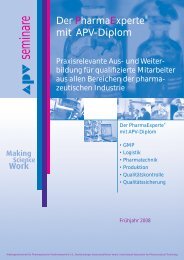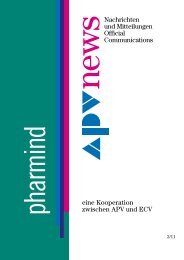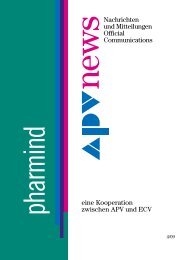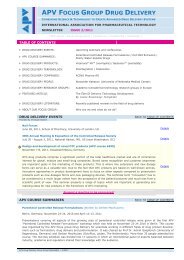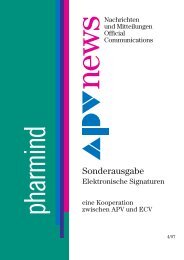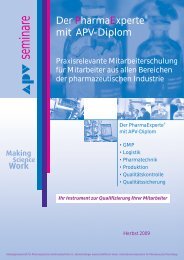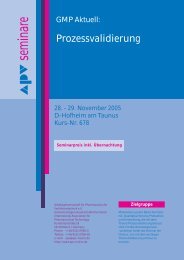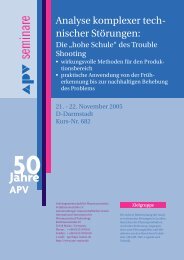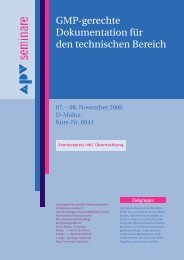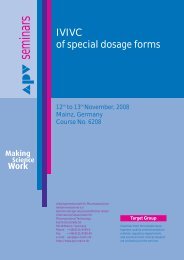APV FOCUS GROUP DRUG DELIVERY
APV FOCUS GROUP DRUG DELIVERY
APV FOCUS GROUP DRUG DELIVERY
Create successful ePaper yourself
Turn your PDF publications into a flip-book with our unique Google optimized e-Paper software.
TABLE OF CONTENTS<br />
<strong>APV</strong> <strong>FOCUS</strong> <strong>GROUP</strong> <strong>DRUG</strong> <strong>DELIVERY</strong><br />
COMBINING SCIENCE & TECHNOLOGY TO CREATE ADVANCED <strong>DRUG</strong> <strong>DELIVERY</strong> SYSTEMS<br />
INTERNATIONAL ASSOCIATION FOR PHARMACEUTICAL TECHNOLOGY<br />
NEWSLETTER ISSUE 3/2011<br />
| <strong>APV</strong> Home | Focus Group Home | Contact us | Unsubscribe | Disclaimer |<br />
◊ <strong>DRUG</strong> <strong>DELIVERY</strong> EVENTS: Upcoming seminars and conferences<br />
◊ <strong>DRUG</strong> <strong>DELIVERY</strong> PRODUCTS: Buccolam ® (ViroPharma) / Nucynta ® ER (Janssen Pharmaceuticals)<br />
◊ <strong>DRUG</strong> <strong>DELIVERY</strong> TERMINOLOGY:<br />
◊ <strong>DRUG</strong> <strong>DELIVERY</strong> COMPANIES: SkyePharma<br />
Nanotechnology / Nanomedicine<br />
◊ <strong>DRUG</strong> <strong>DELIVERY</strong> PEOPLE: Dr. Andreas Briel (nanoPET Pharma)<br />
◊ <strong>DRUG</strong> <strong>DELIVERY</strong> RESEARCH <strong>GROUP</strong>S: Academic transdermal technology research groups in Europe<br />
◊ FEATURED ARTICLE: TTS Manufacturing Technology<br />
By Michael Horstmann<br />
◊ <strong>DRUG</strong> <strong>DELIVERY</strong> LITERATURE: Recently published reviews in the field of drug delivery<br />
◊ ABOUT OUR <strong>FOCUS</strong> <strong>GROUP</strong>: Who are we and what do we do?<br />
<strong>DRUG</strong> <strong>DELIVERY</strong> EVENTS BACK TO TABLE OF CONTENTS<br />
Provided by Christoph Blümer<br />
◊<br />
Design and development of novel OTC products (<strong>APV</strong> course 6390)<br />
November 7-8, 2011, Düsseldorf/Neuss, Germany<br />
Chairs: Dr. Joachim Herrmann, Dr. Willmar Schwabe GmbH & Co KG, Karlsruhe, Germany<br />
Prof. Dr. Johannes Bartholomäus, Pharmakreativ Consulting, Aachen, Germany<br />
OTC-drug products comprise a significant portion of the total healthcare market and are of commercial<br />
interest for global, midsize and small drug companies. Brand name recognition and customer awareness<br />
are important goals in the marketing of these products. This is where line extensions and new dosage<br />
forms can serve as a valuable tool. Due to the fact that OTC products are based on well-known actives,<br />
innovative approaches in product development have to focus on other aspects compared to prescription<br />
products such as new dosages forms and new packaging devices. The technical term “innovation” has to<br />
be considered to a much larger extent from the perspective of the patient/costumer and much less from a<br />
scientific point of view. This seminar presents a range of topics which are important in generating and<br />
realizing ideas for new products in the framework of OTC-marketing.<br />
Nanocarriers for drug delivery (<strong>APV</strong> Course 6409)<br />
November 17-18, 2011, Berlin, Germany<br />
Chairs: Prof. Dr. Karsten Mäder, Martin Luther University Halle/Saale, Germany<br />
Dr. Carsten Olbricht, Bayer Schering Pharma AG, Berlin, Germany<br />
It is the aim of the workshop to provide an overview of different types of nanocarrier and to discuss what<br />
they do and do not share in common. Well known scientists from industry and academia will provide de-<br />
tailed information on the physicochemical properties and the biofate of liposomes, polymer nanoparticles,<br />
nanosized liquid crystals, solid lipid nanoparticles, nanoemulsions, nanostructured lipid carriers, nanosus-<br />
pensions, water soluble polymer conjugates, polymer micelles and nanodiagnostics. The challenges the<br />
Pharma Industry face in developing nanocarriers will also be covered. The workshop will enable the participants<br />
to identify critical aspects of nanocarriers and to evaluate, select and improve the carrier, the<br />
material and the process in a rational, performance based way.<br />
Suggest a meeting to be announced!<br />
Details<br />
Details<br />
<strong>APV</strong> Drug Delivery Focus Group Newsletter – 3/2011 Page 1 of 14
<strong>DRUG</strong> <strong>DELIVERY</strong> PRODUCTS BACK TO TABLE OF CONTENTS<br />
Provided by Dr. Louise Rosenmayr-Templeton<br />
Buccolam ® (ViroPharma)<br />
On 6 Sept 2011 ViroPharma announced that the European Commission had granted a Centralized Paediatric Use<br />
Marketing Authorization (PUMA) for Buccolam ® (midazolam, oromucosal solution) [1]. This medication is indicated for<br />
treatment of prolonged, acute, convulsive seizures in infants, toddlers, children and adolescents, from 3 months to less<br />
than 18 years of age. This action follows the product receiving a positive opinion from the Committee for Medicinal<br />
Products for Human Use (CHMP) of the European Medicines Agency in June [2]. This approval is the very first granted<br />
through the centralised PUMA procedure which is for medicinal products exclusively for paediatric use. The procedure<br />
was designed to encourage companies to conduct paediatric development on previously authorised medicines that are no<br />
longer subject of a supplementary protection certificate (SPC) or a patent qualifying for a SPC [3].<br />
Buccolam is a pre-measured, age-specific dose formulation for buccal administration. It is supplied as prefilled syringes<br />
containing 2.5 mg drug. Approval was based on the results of five clinical trials in a total of 688 children [4]. In four of<br />
these studies the buccal formulation was compared to rectally administered diazepam, the current standard treatment.<br />
The results of these studies show that Buccolam is either comparable or superior, in terms of both effectiveness and<br />
speed of onset of action, to the present therapy. In addition, its administration via the buccal route is far more<br />
convenient and less distressing for both patient and carer alike [1, 4].<br />
The approval triggers an additional payment of £10 million sterling to the former owners of Auralis Limited [1], the<br />
company which originally developed the product and which was acquired by ViroPharma in May2010 [5].<br />
Nucynta ® ER (Janssen Pharmaceuticals)<br />
On 25 August 2011 the FDA approved Nucynta extended-release oral tablets C-II from Janssen Pharmaceuticals Inc [6].<br />
The tablets contain the mu-opioid agonist, tapentadol, and are indicated for the treatment of moderate to severe chronic<br />
pain in adults where 24-hour pain relief is required for an extended period. They are available in 50 mg, 100 mg, 150<br />
mg, 200 mg and 250 mg strengths and are for twice daily administration. The film-coated tablets contain polyethylene<br />
oxide, hypromellose, polyethylene glycol and alpha-tocopherol.<br />
The efficacy of Nucynta ER was demonstrated in one randomized active and placebo controlled study in lower back pain<br />
(LBP) and one randomized placebo controlled trial in patients suffering from painful diabetic peripheral neuropathy<br />
(DPN). The studies showed that after 15 and 12 weeks respectively, patients receiving Nucynta ER in the LBP and DPN<br />
studies had significantly less pain than those taking placebo.<br />
References and Further Information<br />
[1] ViroPharma's Buccolam® (Midazolam, Oromucosal Solution) Granted European Marketing Authorization for<br />
Treatment of Acute Seizures<br />
http://ir.viropharma.com/releasedetail.cfm?ReleaseID=603415 (Accessed on 30.9.2011)<br />
[2] ViroPharma Announces Positive CHMP Opinion for Buccolam® (Midazolam, Oromucosal Solution) in the European Union<br />
http://ir.viropharma.com/releasedetail.cfm?ReleaseID=587147 (Accessed on 30.9.2011)<br />
[3] Questions and Answers on the Paediatric Use Marketing Authorisation (PUMA)<br />
http://www.ema.europa.eu/docs/en_GB/document_library/Other/2011/09/WC500112071.pdf<br />
(Accessed on 30.9.2011)<br />
[4] Buccolam: EPAR - Product Information on EMA website<br />
http://www.ema.europa.eu/ema/index.jsp?curl=pages/medicines/human/medicines/002267/human_med_001479<br />
.jsp&mid=WC0b01ac058001d124 (Accessed on 30.9.2011)<br />
[5] Annual Report 2010 on ViroPharma website<br />
http://ir.viropharma.com/annuals.cfm (Accessed on 30.9.2011)<br />
[6] Entry on Nucynta ER on Drugs@FDA<br />
http://www.accessdata.fda.gov/scripts/cder/drugsatfda/index.cfm?fuseaction=Search.Label_ApprovalHistory#app<br />
hist (Accessed on 30.9.2011)<br />
<strong>DRUG</strong> <strong>DELIVERY</strong> TERMINOLOGY BACK TO TABLE OF CONTENTS<br />
Provided by Dr. Karsten Cremer<br />
NANOTECHNOLOGY<br />
The design, manufacture, characterisation, and application of structures, devices, and systems by controlled<br />
manipulation of size and shape at the atomic, molecular, and macromolecular level and nanometre scale,<br />
associated with at least one characteristic or property which is exclusively due to the nanoscale.<br />
Write a comment on this definition<br />
There is much debate on the proper definition of nanotechnology. Most definitions that the scientific community or<br />
organisations have come up with to date have included a size limit of below 100 nm, which is the scale at which<br />
<strong>APV</strong> Drug Delivery Focus Group Newsletter – 3/2011 Page 2 of 14
size-dependent quantum effects come to bear (see e.g. the definition by the US National Science Foundation<br />
(http://www.nsf.gov/crssprgm/nano/reports/omb_nifty50.jsp). Currently, however, there is a trend to challenge the 100<br />
nm size limit as it excludes numerous materials and devices, especially in the pharmaceutical field. For example, a<br />
liposome whose surface is spiked with a defined number of targeting and/or cell penetration ligands would typically have<br />
a diameter of above 100 nm and, thus, not fall within the scope.<br />
NANOMEDICINE<br />
Nanotechnology applied to medicine. Write a comment on this definition<br />
Nanomedicine includes various subcategories of nanotechnology, such as material science, molecular nanotechnology,<br />
bionanotechnology, interface and colloid science, nanosensors, and potentially also nanorobotics and nanoelectromechanics.<br />
An example of a nanocarrier useful in nanomedicine is a crosslinked micelle whose surface is modified with a<br />
cell-specific targeting moiety.<br />
Suggest a term to be defined Suggest a definition<br />
<strong>DRUG</strong> <strong>DELIVERY</strong> COMPANIES BACK TO TABLE OF CONTENTS<br />
Provided by Jeffry Grunkemeyer<br />
SKYEPHARMA (London, UK)<br />
SkyePharma is a specialist drug delivery company developing oral and inhalation products. With a wide range of<br />
patented and proven technologies, SkyePharma helps to make good drugs better.<br />
We partner with a wide variety of companies from big Pharma, such as GlaxoSmithKline, Novartis, Sanofi-aventis,<br />
AstraZeneca and Roche to a range of smaller speciality pharmaceutical companies. SkyePharma’s proprietary drug<br />
delivery technologies enable the development of new formulations of existing products as well as new chemical entities<br />
to provide a clinical benefit to patients.<br />
Founded: 1996<br />
Location: Headquarters: London, UK<br />
R&D: Muttenz (Basel), Switzerland<br />
Manufacturing: Lyon, France<br />
Ownership: Public company, listed on the London Stock Exchange<br />
Employees: 212<br />
Key technology: Developing Oral and Inhalation Products<br />
SkyePharma’s Geomatrix and Geoclock technologies enable controlled- or timed-release versions<br />
of immediate-release products to be developed providing advantages to both partner companies<br />
and patients.<br />
The Group’s inhalation technologies include formulation as well as device technologies and<br />
encompass metered dose inhalers and dry powder inhalers.<br />
With research and development facilities in Switzerland and manufacturing in France, SkyePharma<br />
offers a comprehensive range of services from feasibility through to commercial scale manufacture.<br />
Oral Formulation Technologies<br />
FORMULATION CHALLENGE SKYEPHARMA SOLUTION<br />
Specific modified release pattern Geomatrix<br />
Time release / Chronotherapy Geoclock<br />
Multiple pulse profile GeoPulse<br />
Low bioavailability (BCS II and BCS IV) Insoluble Drug Delivery (IDD). Dissocubes<br />
Upper GIT delivery / absorption window Gastro-Retentive Systems (OGRS)<br />
First Pass Effect / rapid onset Medicated Chewing Gum - GeoGum<br />
Abuse deterrence (eg opioids, controlled substances) Tamper resistant formulation<br />
<strong>APV</strong> Drug Delivery Focus Group Newsletter – 3/2011 Page 3 of 14
Inhalation Technologies<br />
FORMULATION CHALLENGE SKYEPHARMA SOLUTION<br />
Robust and reproducible dosing<br />
Long room temperature shelf life (≥ 2years)<br />
SkyePharma formulation and device<br />
technologies aim to achieve this<br />
SkyeProtect TM SkyeDry TM , and SkyeStabe TM<br />
technologies<br />
Moisture protection SkyeProtect amd SkyeDry<br />
Breath actuation vs. active drug dispersion<br />
Flow rate independent dosing with breath actuated<br />
devices<br />
Efficient lung deposition<br />
Target delivery to specific lung regions, e.g. deep<br />
lung deposition for systemic uptake<br />
SkyeHaler TM DPI is breath actuated; MDI is<br />
active dispersion, which can be coupled to<br />
breath actuation, e.g. BAI<br />
SkyeHaler DPI achieves this via a threshold<br />
flow rate and medium resistance<br />
SkyeFine TM when necessary<br />
ISS-P TM nanotechnology<br />
Products: There are twelve products approved in the areas of oral, inhalation and topical delivery and additional<br />
products submitted for approval that incorporate the Group’s proven proprie-<br />
tary technologies. The Group’s products are marketed throughout the world by leading pharmaceutical<br />
companies.<br />
Approved Products<br />
LICENSEE/ PRODUCT<br />
PARTNER NAME<br />
INHALATION<br />
GENERIC NAME INDICATION MARKETED<br />
®<br />
AstraZeneca Pulmicort HFA-MDI Budesonide Asthma yes<br />
ORAL<br />
®<br />
sanofi-aventis Xatral OD/<br />
Alfuzosin BPH yes<br />
Uroxatral ®<br />
GlaxoSmithKline<br />
®<br />
Requip<br />
Once-a-day<br />
Ropinirole Parkinson’s disease yes<br />
GlaxoSmithKline Paxil CR Paroxetine Depression yes<br />
Sciele Pharma<br />
(Shionogi)<br />
Sciele Pharma<br />
(Shionogi)<br />
Triglide ®<br />
Sular ®<br />
Madopar DR ®<br />
Roche Levodopa +<br />
Benserazide<br />
Cornerstone<br />
Therapeutics<br />
ZYFLO CR ®<br />
Fenofibrate Lipid disorders yes<br />
Nisoldipine Hypertension yes<br />
Parkinson’s disease yes<br />
Zileuton Asthma yes<br />
Coruno ®<br />
Therabel Molsidomine Angina yes<br />
Ratiopharm diclofenac-<br />
®<br />
ratiopharm uno<br />
Diclofenac Pain/inflammation yes<br />
Lodotra ®<br />
Horizon Europe Prednisone Rheumatoid arthritis yes<br />
TOPICAL<br />
Solaraze ®<br />
Nycomed/Almirall Diclofenac Actinic keratosis yes<br />
<strong>APV</strong> Drug Delivery Focus Group Newsletter – 3/2011 Page 4 of 14
Development<br />
status:<br />
Pipeline Products<br />
LICENSEE/<br />
PARTNER<br />
SkyePharma<br />
(US)<br />
Mundipharma<br />
(Europe)<br />
Kyorin<br />
(Japan)<br />
Horizon<br />
(US)<br />
Partnerships: See above<br />
PRODUCT ACTIVE PRIMARY<br />
INDICATION<br />
Flutiform Formoterol<br />
Fluticasone<br />
Flutiform Formoterol<br />
Fluticasone<br />
Flutiform Formoterol<br />
Fluticasone<br />
Lodotra® Prednisone Rheumatoid<br />
arthritis<br />
PH I PH II PH III<br />
Asthma Complete Complete Complete<br />
Asthma Complete Complete Complete<br />
Asthma Complete<br />
Somnus SKP-1041 Zaleplon Sleep<br />
maintenance<br />
Somnus SKP-1052 Diabetes 2011<br />
Website: http://www.skyepharma.com<br />
Contact: Yves Decadt, VP Business Development<br />
Eptingerstrasse 61<br />
CH-4132 Muttenz<br />
Switzerland<br />
Office: +41 61 467 5531<br />
Mobile: +41 78 655 3950<br />
E-Mail : y.decadt@skyepharma.com<br />
Complete Complete<br />
Complete In progress<br />
<strong>DRUG</strong> <strong>DELIVERY</strong> PEOPLE BACK TO TABLE OF CONTENTS<br />
Provided by Prof. Dr. Karsten Mäder<br />
DR. ANDREAS BRIEL studied chemistry at the Philipps University in Marburg<br />
(Germany) with the main focus on physical chemistry of polymers and subsequently<br />
developed research interests in the field of structure control of macromolecules with<br />
different nanoarchitectures. He completed his PhD studies in 1996 at the Max Planck<br />
Institute of Colloids and Interfaces (studying classical polyelectrolyte effects in<br />
polymer analytics).<br />
In 1997 he joined Schering AG in Berlin and worked for 3 years on the pharmaceutical<br />
development of Ultrasound Contrast Agents (supporting Phase I & II clinical<br />
trials) and was international project team leader for novel contrast agents. Hereafter<br />
he spent 2 years in the Drug Delivery Systems department and 2 years in the<br />
CMC Technology Office of Schering, evaluating recent developments in drug delivery<br />
technologies. From 2004 to 2008, he was involved in Schering’s Corporate Research<br />
Business Area “Diagnostic Imaging” and successfully established his own research<br />
team dealing with special research topics on nanomedicines.<br />
As a founder and since June 2008 the Managing Director of nanoPET Pharma GmbH,<br />
Berlin, he is in charge of a Diagnostic Imaging company with currently 14 employees<br />
and 21 diagnostic imaging products marketed worldwide (www.viscover.com).<br />
Andreas is a proven expert in Nanotechnology, in vivo Diagnostics and Drug Delivery Systems.<br />
He is chairman of the Association of Colloids and Interfaces Berlin/Brandenburg, founded in 2001, and since 2003 he is<br />
also lecturer for “Novel Technologies and Innovation” at the University of Applied Sciences in Berlin. Additionally, he is<br />
involved in several initiatives as a consultant to the German government (e.g. BMBF-NanoforLife) and the European<br />
Commission (e.g. European Nanotechnology Platform on Nanomedicine) and the European Science Foundation (Forward<br />
Look on Nanomedicine) to define a common future vision regarding Nano(Bio)Medicine and the development of a strategic<br />
research agenda, which identifies research and innovation priorities to implement this vision at an European level.<br />
<strong>APV</strong> Drug Delivery Focus Group Newsletter – 3/2011 Page 5 of 14
<strong>DRUG</strong> <strong>DELIVERY</strong> ACADEMIC RESEARCH <strong>GROUP</strong>S BACK TO TABLE OF CONTENTS<br />
Provided by Dr. Georg Böck<br />
This is the second issue of the recently established newsletter section, intended to give a brief tabulated overview on<br />
academic groups of European Universities working in a distinct drug delivery area. In this issue groups working on<br />
PULMONARY <strong>DRUG</strong> <strong>DELIVERY</strong> are presented.<br />
Almost all internet websites of European universities offering the study of pharmacy have been evaluated for key words<br />
like e.g. respiratory, pulmonary, inhalation, inhaler, inhale, aerosol, nebulizer, nebulize and lung. Ten groups have been<br />
identified. The author would like to encourage all readers to feed back if a group is missing. This list is not intended to<br />
be comprehensive and it is a living document to be updated from time to time. Contact<br />
Belgium, Brussels<br />
Institution Catholic University of Louvain (UCL – Brussels), Belgium.<br />
Group Pharmaceutical Technology Unit<br />
Key contact Prof. Dr. Véronique Préat<br />
Website http://www.uclouvain.be/en-farg.html<br />
E-Mail Veronique.Preat@uclouvain.be<br />
• Inhalation aerosols of biotech drugs.<br />
• Systemic absorption of peptides and proteins from the lung.<br />
• Design of dry powder aerosols with elevated deep lung deposition.<br />
• Excipient selection for pulmonary drug delivery; GRAS excipients with potential vaccine adju-<br />
Research areas vant properties.<br />
• Bioavailability of inhaled macromolecules in the lung.<br />
• Vaccine delivery to the lung and clearance by alveolar macrophages.<br />
• Optimization of immunization efficacy by designing dry powder aerosols with an appropriate<br />
deposition within the lung.<br />
Germany, Bonn<br />
Institution Rheinische Friedrich-Wilhelms-Universität, Bonn, Germany.<br />
Group Fachgruppe Pharmazie / Pharmazeutische Technologie<br />
Key contact Prof. Dr. Klaus-Jürgen Steffens<br />
Website http://www.pharma.uni-bonn.de/www/pharmtech/forschung/steffens<br />
E-Mail steffens@uni-bonn.de<br />
Research areas<br />
Germany, Kiel<br />
• Aerosolization of liquids, nebulization, Laval nozzle.<br />
• Spray-dried powders for inhalation.<br />
• Particle disaggregation of spray-dried proteins<br />
• Surface modification of lactose for inhalation with scCO2.<br />
Institution Christian-Albrechts-Universität zu Kiel, Germany.<br />
Group Department of Pharmaceutics and Biopharmaceutics<br />
Key contact Prof. Dr. Hartwig Steckel<br />
Website http://www.uni-kiel.de/Pharmazie/technologie/eng/rf.htm<br />
E-Mail rmueller@pharmazie.uni-kiel.de<br />
Research areas<br />
• Pharmaceutical aerosols (DPI, MDI, powder rheology, particle sizing, nebulizers).<br />
• Dry powder inhalers (drug spheronisates, novel inhaler devices, novel formulation strategies<br />
for DPIs).<br />
• Metered-dose inhalers (precipitation in liquefied propellant, nanoparticles).<br />
• Aerosol particle sizing (impaction devices, laser diffraction, image analysis, novel optical aerosol<br />
particle size distribution measurement system).<br />
• Nebulizers (aqueous solutions and suspensions, cyclodextrin enabled solubilized systems,<br />
freeze drying of proteins and peptides, nano-supensions).<br />
• Nasal delivery (nasal powder formulations for NCE and NBE).<br />
<strong>APV</strong> Drug Delivery Focus Group Newsletter – 3/2011 Page 6 of 14
Germany, Marburg<br />
Institution Philipps–Universität Marburg, Germany.<br />
Group Institut für Pharmazeutische Technologie und Biopharmazie<br />
Key contact Prof. Dr. Thomas Kissel<br />
Website http://www.uni-marburg.de/fb16/iptb/forschung/akkissel/forschung<br />
E-Mail kissel@staff.uni-marburg.de<br />
Research areas<br />
Germany, Saarbrücken<br />
• Inhalative depot formulations<br />
• Encapsulation, release and degradation of tailor-made bio-degradable polymers.<br />
• Stabilization and characterization of nano-supsensions.<br />
• Characterization of nanoparticles by dynamic light scattering, laser diffraction and cascade<br />
impaction (NGI).<br />
• Treatments with various types of nebulizers and DPIs.<br />
• Ex vivo research with isolated rabbit lungs.<br />
Institution Universität des Saarlandes, Saarbrücken, Germany<br />
Group Biopharmazie und Pharmazeutische Technologie<br />
Key contact Prof. Dr. Claus-Michael Lehr<br />
Website<br />
http://www.uni-saarland.de/de/campus/fakultaeten/professuren/ naturwissenschaftlichtechnische-fakultaet-iii/pharmazie/professuren-fr-82-pharmazie/lehr/research.html<br />
E-Mail lehr@mx.uni-saarland.de<br />
Research areas<br />
United Kingdom, Cardiff<br />
• Biological barriers / respiratory tract.<br />
• NanoINHALE: cell culture based in vitro testing of the retarding effect and biocompatibility of<br />
extended release formulations in the lung; clearance of particles from the lung.<br />
• NanoCARE: adhesion, permeation and cell uptake of nanoparticles to lung cells.<br />
• Inhalable carrier systems for the cellular targeting of telomerase inhibitors.<br />
Institution Cardiff University, United Kingdom.<br />
Group Pharmaceutical Technology<br />
Key contact Prof. Glyn Taylor<br />
Website http://www.cardiff.ac.uk/phrmy/contactsandpeople/fulltimeacademicstaff/taylor-glynnew.html<br />
E-Mail taylorg@cf.ac.uk<br />
Research areas<br />
United Kingdom, Kent<br />
• Pulmonary barriers to drug absorption.<br />
• Enhancing the systemic delivery of protein and peptide drugs using agents which alter the<br />
nature of the biological barrier to absorption.<br />
• Physical methods to produce aerosols optimised for specific regional deposition in the respiratory<br />
tract.<br />
Institution Medway School of Pharmacy, Kent, United Kingdom.<br />
Group Chemistry and drug delivery<br />
Key contact Prof Iain Cumming<br />
Website http://www.msp.ac.uk/about/staff/iain-cumming.html<br />
E-Mail k.i.cumming@gre.ac.uk<br />
Research areas<br />
• Transdermal, controlled release, pulmonary and nanoparticle drug delivery systems and their<br />
application to pharmaceutical products.<br />
<strong>APV</strong> Drug Delivery Focus Group Newsletter – 3/2011 Page 7 of 14
United Kingdom, Liverpool<br />
Institution Liverpool John Moores University, United Kingdom.<br />
Group School of Pharmacy and Biomolecular Sciences / Drug Delivery and Material Sciences<br />
Key contact Prof. James Ford<br />
Website http://www.ljmu.ac.uk/PBS/research/drugdelivery/Index.htm<br />
E-Mail j.l.ford@ljmu.ac.uk<br />
Research areas<br />
United Kingdom, London<br />
• Bio and non-biodegradable polymeric porous materials as articles for aerosol delivery.<br />
• Models of upper airways to predict formulation performance. Inertial impaction techniques<br />
(ACI, MSLI, TSI).<br />
• Porous polymer formulations for aerosol delivery to the lungs.<br />
Institution King’s College London, United Kingdom.<br />
Group Drug Delivery Group Research<br />
Key contact Professor Gary P. Martin<br />
Website http://www.kcl.ac.uk/schools/biohealth/research/pharmsci/research/groups/delivery/<br />
E-Mail gary.martin@kcl.ac.uk<br />
Research areas<br />
Netherlands, Groningen<br />
• Novel strategies for drug delivery by inhalation and the treatment of respiratory disease.<br />
• Aerosol formulations from dry powder and pressurized inhaler devices.<br />
• Biopharmaceutics of particle-cell interaction, including gene therapy, and the characterization<br />
of bacteria in lung diseases such as cystic fibrosis.<br />
• Inhaled drug dosimetry, disposition, toxicity and pharmacokinetics.<br />
Institution University of Groningen, Netherlands<br />
Group Department of Pharmaceutical Technology and Biopharmacy<br />
Key contact Dr. Anne de Boer<br />
Website<br />
http://www.rug.nl/fmns-research/pharmaceutical-technology-andbiopharmacy/research/inhalatieonderzoek<br />
E-Mail a.h.de.boer@rug.nl<br />
Research areas<br />
• Design and development of new dry powder inhalers (Novolizer, Twincer).<br />
• Formulation development for dry powder inhalers.<br />
• Aerosol characterization techniques.<br />
• Clinical research using dry powder inhalers.<br />
Disclaimer: Although every effort has been made to check the accuracy of the contents of the tables, there may be<br />
some inaccuracies and/or omissions.<br />
FEATURED ARTICLE BACK TO TABLE OF CONTENTS<br />
TTS MANUFACTURING TECHNOLOGY<br />
By Michael Horstmann, PhD, tesa SE, Hamburg, Germany<br />
1. Introduction<br />
As manufacturing of transdermal products is not routine practice in pharmaceutical companies, introduction of<br />
manufacturing technology for this dosage form presents scientific and financial hurdles which can discourage firms from<br />
exploiting this route of delivery. However, these hurdles can be overcome by the selection of a suitable specialized and<br />
experienced partner for production.<br />
This selection should ideally occur when the product is still at an early stage, as it is a key necessity to take into account<br />
process line requirements right at the start of the development of a new transdermal formulation. Aveva, Noven, LTS,<br />
Acino, Teikoku Seiyaku, Nitto and Hisamitsu are examples of established service providers of transdermal manufacturing,<br />
while others, such as Corium in the US or tesa’s new pharma site in Hamburg, Germany, are newer entrants to this<br />
field.<br />
<strong>APV</strong> Drug Delivery Focus Group Newsletter – 3/2011 Page 8 of 14
Generally, there are nine standard process elements in transdermal manufacture which correspond to different<br />
production phases:<br />
1. Processes for the API, its particle structure and its potential embedding in pre-processed coatings, complexes or<br />
aggregates<br />
2. Processes to dissolve essential individual excipients like polymers<br />
3. Manufacture of the coatable / spreadable mass(es), with or without API<br />
4. Coating and drying<br />
5. Lamination processes<br />
6. Slitting<br />
7. Converting<br />
8. Primary packaging<br />
9. Secondary packaging<br />
Despite in later phases being continuous by design, transdermal processes are batch-driven as it is difficult to produce<br />
the spreadable mass containing the API in a homogenous, continuous fashion. If laminates with different<br />
drug-containing layers are used, it is common to define the layer with the highest drug content as batch-defining.<br />
2. History<br />
“Emplastra” were in a very simple sense the predecessors of transdermal therapeutic systems. They were first produced<br />
in ancient times (Egypt, Greece, Rome, and mediaeval times in Europe). Late in the 19 th century, these traditional<br />
formulae were first "industrialized" by means of "drug in adhesive" continuous spreading and solidification processes.<br />
Between about 1890 and 1960, these products fell out of fashion and in consequence the underlying processes were<br />
also forgotten apart from a few exceptions.<br />
Alza's re-invention of topical and systemic transdermal therapy began with a combination of a reservoir with a<br />
controlling membrane layer in a patch. This concept was considered both new (compared to previous systems) and<br />
simple (involved simple lamination processes). It dominated production and design technology between 1970 and 1990.<br />
Most systems during this period were produced by combining / laminating drug-free laminates of industrial adhesive<br />
layers (available as commodities) with foil-like membranes. Initially only liquid-containing, sealed reservoirs of the drug<br />
ingredient were generated e.g. in the case of Estraderm ® , the first hormone patch. In other examples, the active<br />
ingredient was dissolved or dispersed in a layered reservoir structure which was quite often devoid of adequate adhesive<br />
characteristics. In all these processes, no large investments in coating and drying equipment were necessary and<br />
production lines could be kept simple and comparatively small. However, these patches had some disadvantages in<br />
terms of visual appearance and/or performance.<br />
With the introduction of the first matrix (drug in adhesive) systems in the 1980s and 1990s (e.g. Nitro-Dur ® , Deponit ®<br />
for nitroglycerin, Systen ® , Fem7 ® , Dermestril ® for estradiol), systems became more flexible and consumer-friendly and,<br />
due to the omission of restricting membranes, drug utilization increased with reduced patch size. These technologies<br />
were in many cases initially created and honed in the hands of medical adhesive makers like Nitto, 3M, Beiersdorf and<br />
Lohmann. Skilled owners and operators of pre-existing industrial process lines for coating, drying and laminating on a<br />
large scale converted them into pharma lines. This process is still going on.<br />
3. Established standard process sequence<br />
According to ”Quality by Design” principles, the formulation should get more rugged to the peculiarities and challenges<br />
of the process. However, in the case of transdermal formulations, innovative developers tend to add new risk factors<br />
(like the addition of volatile enhancers, phase borders, polymer blends and borderline saturation status of the API)<br />
rather than reduce them. This is the unique challenge of formulation in conjunction with process design and requires a<br />
high degree of interdisciplinary thinking. Most transdermal formulations contain the API in solution, a state in which it<br />
must reliably remain during the entire shelf life of the product. However, there have been cases where under certain<br />
storage conditions, re-crystallisation of the active ingredient occurred. This issue can be avoided by the performance of<br />
adequate solubility studies in the full knowledge that polymers tend to super-saturate any monomeric compound quite<br />
efficiently. Less known is the fact that re-crystallisation may even occur in the case of solid drug dispersions in the<br />
formulation. Like in ointments, there is a tendency for larger crystals to grow and smaller particles to shrink due to<br />
dissolution. The best and most sensible method to monitor for changes of this kind are in-vitro release profile tests.<br />
Nowadays most polymers are available ready dissolved in organic solutions. Despite this it may be advisable for the<br />
drug delivery manufacturing companies to carry out polymer dissolution as this gives better process control and more<br />
flexibility in switching pharmacopoeial solvent quality. However, novices in this technology will be surprised as to the<br />
many mistakes that can be made which extend polymer dissolution time unnecessarily. In order to dissolve, for<br />
example, polyisobutylene (PIB) or synthetic rubber, it is first necessary to generate freshly calendered-flat sheets as<br />
these enable even access of solvent to the polymer during the dissolution process. Further processing has to be done in<br />
<strong>APV</strong> Drug Delivery Focus Group Newsletter – 3/2011 Page 9 of 14
a closed, explosion-proof environment, where high-shear kneading processes as well as solvent diffusion contribute to<br />
polymer dissolution. Care needs to be taken not to reduce the molecular weight of the polymer by mechanical force.<br />
After sometimes several days, a clear, isotropic solution of the polymer is achieved.<br />
The main factors controlling content and content<br />
uniformity, besides the solids content in the homogenous<br />
coating mass, is the exactness of the<br />
caliper of the coating substrate, the choice of the<br />
coating process and the precision and selection of<br />
the tooling.<br />
Numerous practical ways of spreading liquid or<br />
semi-solid masses on a web-like substrate are<br />
established. What most of them have in common<br />
is that a gap is formed between two rollers or a<br />
roller and a blade, which not only accomodates<br />
the adhesive, but also the substrate which thus<br />
adds to the caliper variability of the rollers. This is<br />
the reason why in general roll coaters may contribute rhythmic variabilities which follow sinusoidal curves of different<br />
frequency dependent on roller geometry, individual speed or even the caliper variability of the basis foil. For thin layers<br />
of less than 50 micrometres solid thickness, it is for physical reasons already difficult to obtain less than 5 % variability<br />
with roller coaters.<br />
Coating process – the art of reproducible dosing<br />
Independent of the proceeding information, current pharmaceutical coating processes for transdermals include:<br />
• Roll or knife-over roll coating processes, where the gap between a roller and another roll / knife determines<br />
dosage accuracy. The support foil contributes to the imprecision by its own tolerability. There are no severe and<br />
unexpected contributions from machine speed variation.<br />
• Extrusion processes. The coating mass is extruded through a flat die. The precision is mainly dictated by the<br />
constancy of the pumping system as well as the precision of the flat extrusion die over the width. As this<br />
extrusion process is independent of the line speed, a strict ratio needs to maintained and controlled. On the<br />
other hand, there is less dependence on substrate quality. The main application is hot melt extrusion.<br />
Both general process methodologies have their value and are the basis of successful production processes for layers of<br />
about 30 to 100 micrometres with high precision and content uniformity.<br />
Drying processes<br />
Being connected to the dosing equipment, drying usually<br />
attracts less attention but it involves a larger share of the<br />
commercial effort and investment. Obviously, removal of<br />
process solvents is the main target, usually within the limits<br />
given by the ICH residual solvents guideline. Exceeding<br />
certain temperature limits may however lead to losses and<br />
excessive degradation. In real life, process developers need to<br />
compromise between acceptable volatile residues, acceptable<br />
losses and degradation.<br />
The initial phase of drying involves lower temperatures at high<br />
speed; in later phases, diffusion of solvents within the matrix<br />
prevails as the process-time dictating phenomenon. In this<br />
later phase, the temperature is raised continuously based on<br />
experience and experimental trials in order to facilitate<br />
diffusion but avoid formation of bubbles.<br />
Printing processes<br />
In case of volatile ingredients, specifically active ingredients, coating processes cannot ensure that all of the active ingredient<br />
is retained during drying. Application of the active ingredient in liquid form or in a polymeric dilution is the<br />
solution of choice for this problem. This may be both done in the first part of the process by soaking a non-woven substrate<br />
with the active ingredient which is then laminated between two adhesive layers. These layers subsequently get<br />
saturated with active ingredient.<br />
Another possibility is to transfer this technology to a disk-like placing process on the converting line, where printing /<br />
soaking with the active solution can be performed just prior to the individualization of the systems. Also, screen printing<br />
processes have been tried but to our knowledge these have not yet been used to a significant<br />
extent for pharma applications.<br />
<strong>APV</strong> Drug Delivery Focus Group Newsletter – 3/2011 Page 10 of 14
Slitting lines<br />
Master rolls which are generated after coating, drying<br />
and laminating are slit to narrow rolls which are<br />
subsequently transferred to the converting line. A critical,<br />
dose-generating role is only included, if products<br />
are cut rectangular in the same width. Nearly all transdermal<br />
systems are dosed in the subsequent converting<br />
step.<br />
Converting lines<br />
Converting lines may be continuous, rotary-tool based<br />
or punching-intermittent in their design. Intermittent<br />
designs accept comparatively simple die-cutting tools<br />
which provide a well-described, exact pre-defined area<br />
and can be easily replaced and changed. As punching<br />
occurs in the non-moving phase of the line action, the precision of dosing is very robust and not impaired by machine<br />
speed. Rotary processes, however, require precise, product-specific and more expensive tooling which needs a<br />
comparatively long time for set-up before production but pays back in higher and reliable speed.<br />
Process validation relies on engineering and<br />
machinery-driven IQ/OQ and the productoriented<br />
PQ (process qualification). Challenges<br />
of critical parameters in a fully qualified environment<br />
in which processing steps are tested<br />
under borderline conditions should nowadays<br />
be performed under the more flexible conceptual<br />
approaches of design-of-experiments<br />
(DOE) and adequate reporting. Formal validation<br />
batches need to be executed and tested at<br />
target conditions and full industrial size.<br />
Future<br />
For decades it has been expected that iontophoresis, microneedles and sonophoresis will take over and expand the<br />
number of molecules suitable for transdermal therapy. This goal looks close now, but will require sophisticated<br />
non-standard process technology. As some of these approaches may impair the antibacterial barrier of the skin, sterile<br />
or at least low bio-burden technologies will prevail in the future.<br />
Summary<br />
Over forty years of production of modern transdermal systems has led to a quite uniform approach which is shared in<br />
practice between a small number of worldwide manufacturers/developers and their Pharma clients. It is advisable for<br />
every company with TTS development intentions, to get early access to production knowledge in order to avoid later<br />
painful experiences by missing the pharmaceutical targets and specifications.<br />
<strong>DRUG</strong> <strong>DELIVERY</strong> LITERATURE BACK TO TABLE OF CONTENTS<br />
Provided by Dr. Karsten Cremer<br />
RECENTLY PUBLISHED LITERATURE REVIEWS IN THE FIELD OF <strong>DRUG</strong> <strong>DELIVERY</strong><br />
Thermosensitive polymeric micelles for targeted drug delivery.<br />
Talelli M, Hennink WE. Nanomedicine. 2011 Sep;6(7):1245-55.<br />
Critical issues in tissue engineering: biomaterials, cell sources, angiogenesis, and drug delivery systems.<br />
Naderi H, Matin MM, Bahrami AR. J Biomater Appl. 2011 Sep 16.<br />
Solid dispersions, Part I: recent evolutions and future opportunities in manufacturing methods for dissolution<br />
rate enhancement of poorly water-soluble drugs. Bikiaris DN. Expert Opin Drug Deliv. 2011 Sep 16.<br />
Microgels and microcapsules in peptide and protein drug delivery.<br />
Bysell H, Månsson R, Hansson P, Malmsten M. Adv Drug Deliv Rev. 2011 Sep 3.<br />
Click Chemistry for Drug Delivery Nanosystems.<br />
Lallana E, Sousa-Herves A, Fernandez-Trillo F, Riguera R, Fernandez-Megia E. Pharm Res. 2011 Sep 13.<br />
Dynamic combinatorial chemistry as a tool for the design of functional materials and devices.<br />
Moulin E, Cormos G, Giuseppone N. Chem Soc Rev. 2011 Sep 12.<br />
<strong>APV</strong> Drug Delivery Focus Group Newsletter – 3/2011 Page 11 of 14
Sonoproduction of Liposomes and Protein Particles as Templates for Delivery Purposes.<br />
Silva R, Ferreira H, Cavaco-Paulo A. Biomacromolecules. 2011 Sep 21.<br />
Progress in Nanoparticulate Systems for Peptide, Proteins and Nucleic Acid Drug Delivery.<br />
Slomkowski S, Gosecki M. Curr Pharm Biotechnol. 2011 Sep 9.<br />
Advanced Trans-Epithelial Drug Delivery Devices.<br />
Ciach T, Moscicka-Studzinska A. Curr Pharm Biotechnol. 2011 Sep 9.<br />
Drug delivery strategies for poorly water-soluble drugs: the industrial perspective.<br />
van Hoogevest P, Liu X, Fahr A. Expert Opin Drug Deliv. 2011 Sep 6.<br />
PEGylation of Proteins and Liposomes: A Powerful and Flexible Strategy to Improve the Drug Delivery.<br />
Milla P, Dosio F, Cattel L. Curr Drug Metab. 2011 Sep 5.<br />
Cationic polymer based nanocarriers for delivery of therapeutic nucleic acids.<br />
Nimesh S, Gupta N, Chandra R. J Biomed Nanotechnol. 2011 Aug;7(4):504-20.<br />
Medical applications of nanoparticles in biological imaging, cell labeling, antimicrobial agents, and anticancer<br />
nanodrugs. Singh R, Nalwa HS. J Biomed Nanotechnol. 2011 Aug;7(4):489-503.<br />
Porous silicon nanowires.<br />
Qu Y, Zhou H, Duan X. Nanoscale. 2011 Aug 25.<br />
Microneedles as Transdermal Delivery Systems: Combination with other Enhancing Strategies.<br />
Nava-Arzaluz MG, Calderón-Lojero I, Quintanar-Guerrero D, Villalobos-García R, Ganem-Quintanar A. Curr Drug Deliv.<br />
2011 Aug 9.<br />
Promising approaches in using magnetic nanoparticles in oncology.<br />
Georgy M, Olga V. Biol Chem. 2011 Aug 18.<br />
Nanotechnology: Emerging Tool for Diagnostics and Therapeutics.<br />
Chakraborty M, Jain S, Rani V. Appl Biochem Biotechnol. 2011 Aug 17.<br />
Cancer Theranostics with Near-Infrared Light-Activatable Multimodal Nanoparticles.<br />
Melancon MP, Zhou M, Li C. Acc Chem Res. 2011 Aug 17.<br />
Cancer nanotheranostics: improving imaging and therapy by targeted delivery across biological barriers.<br />
Kievit FM, Zhang M. Adv Mater. 2011 Sep 22;23(36):H217-47.<br />
Tumor-Targeted Drug Delivery with Aptamers.<br />
Zhang Y, Hong H, Cai W. Curr Med Chem. 2011 Aug 15.<br />
Leveraging the power of ultrasound for therapeutic design and optimization.<br />
Caskey CF, Hu X, Ferrara KW. J Control Release. 2011 Jul 30.<br />
Strategies for the nanoencapsulation of hydrophilic molecules in polymer-based nanoparticles.<br />
Vrignaud S, Benoit JP, Saulnier P. Biomaterials. 2011 Nov;32(33):8593-604.<br />
Chronotherapeutic Drug Delivery Systems - An Approach to Circardian Rhythms Diseases.<br />
Sunil SA, Srikanth MV, Rao NS, Uhumwangho MU, Latha K, Murthy KV. Curr Drug Deliv. 2011 Aug 9.<br />
The ABC of the Blood-Brain Barrier - Regulation of Drug Efflux Pumps.<br />
Reichel V, Mahringer A, Ott M, Reimold I, Fricker G. Curr Pharm Des. 2011 Aug 9.<br />
Oral drug delivery utilizing intestinal OATP transporters.<br />
Tamai I. Adv Drug Deliv Rev. 2011 Jul 30.<br />
In vivo imaging of drug delivery systems in the gastrointestinal tract.<br />
Weitschies W, Wilson CG. Int J Pharm. 2011 Sep 30;417(1-2):216-26.<br />
Molecular aptamers for drug delivery.<br />
Tan W, Wang H, Chen Y, Zhang X, Zhu H, Yang C, Yang R, Liu C. Trends Biotechnol. 2011 Aug 6.<br />
Utilization of monoclonal antibody-targeted nanomaterials in the treatment of cancer.<br />
Julien DC, Behnke S, Wang G, Murdoch GK, Hill RA. MAbs. 2011 Sep 1;3(5).<br />
Lipid nanoemulsions for anti-cancer drug therapy.<br />
Souto EB, Nayak AP, Murthy RS. Pharmazie. 2011 Jul;66(7):473-8.<br />
Oral formulation strategies to improve solubility of poorly water-soluble drugs.<br />
Singh A, Worku ZA, Van den Mooter G. Expert Opin Drug Deliv. 2011 Oct;8(10):1361-78.<br />
Application of supercritical antisolvent method in drug encapsulation: a review.<br />
Kalani M, Yunus R. Int J Nanomedicine. 2011;1429-42.<br />
Developing oral drug delivery systems using formulation by design: vital precepts, retrospect and prospects.<br />
Singh B, Kapil R, Nandi M, Ahuja N. Expert Opin Drug Deliv. 2011 Oct;8(10):1341-60.<br />
Nanoparticles in Oncology: The New Theragnostic Molecules.<br />
Allegra A, Penna G, Alonci A, Rizzo V, Russo S, Musolino C. Anticancer Agents Med Chem. 2011 Jul 25.<br />
Cutaneous reactions to transdermal therapeutic systems.<br />
Bershow A, Warshaw E. Dermatitis. 2011 Aug 1;22(4):193-203.<br />
<strong>APV</strong> Drug Delivery Focus Group Newsletter – 3/2011 Page 12 of 14
The effects of polymeric nanostructure shape on drug delivery.<br />
Venkataraman S, Hedrick JL, Ong ZY, Yang C, Ee PL, Hammond PT, Yang YY. Adv Drug Deliv Rev. 2011 Jul 6.<br />
Nanoparticles and the skin - applications and limitations.<br />
Lane ME. J Microencapsul. 2011 Jul 18.<br />
Drug carriers for vascular drug delivery.<br />
Koren E, Torchilin VP. IUBMB Life. 2011 Aug;63(8):586-95.<br />
Targeted siRNA delivery to diseased microvascular endothelial cells: cellular and molecular concepts.<br />
Kowalski PS, Leus NG, Scherphof GL, Ruiters MH, Kamps JA, Molema G. IUBMB Life. 2011 Aug;63(8):648-58.<br />
Delivery of nanoparticle: complexed drugs across the vascular endothelial barrier via caveolae.<br />
Wang Z, Tiruppathi C, Cho J, Minshall RD, Malik AB. IUBMB Life. 2011 Aug;63(8):659-67.<br />
Vaginal gel drug delivery systems: understanding rheological characteristics and performance.<br />
Yu T, Malcolm K, Woolfson D, Jones DS, Andrews GP. Expert Opin Drug Deliv. 2011 Oct;8(10):1309-22.<br />
Kinetic and Thermodynamic Approaches to the Drug Targeting Phenomena.<br />
Meerovich I, Koshkaryev A, Torchilin V. Curr Drug Discov Technol. 2011 Jul 4.<br />
Gastroretentive microparticles for drug delivery applications.<br />
Adebisi A, Conway BR. J Microencapsul. 2011 Jul 4.<br />
Novel platforms for vascular carriers with controlled geometry.<br />
Pillai JD, Dunn SS, Napier ME, DeSimone JM. IUBMB Life. 2011 Aug;63(8):596-606.<br />
Advances in lymphatic imaging and drug delivery.<br />
Nune SK, Gunda P, Majeti BK, Thallapally PK, Forrest ML. Adv Drug Deliv Rev. 2011 Sep 10;63(10-11):876-85.<br />
Floating drug delivery systems for prolonging gastric residence time: a review.<br />
Sathish D, Himabindu S, Kumar YS, Shayeda, Rao YM. Curr Drug Deliv. 2011 Sep 1;8(5):494-510.<br />
Nanodrug delivery systems in dentistry: a review on current status and future perspectives.<br />
Renugalakshmi A, Vinothkumar TS, Kandaswamy D. Curr Drug Deliv. 2011 Sep 1;8(5):586-94.<br />
Intestinal lymphatic transport for drug delivery.<br />
Yáñez JA, Wang SW, Knemeyer IW, Wirth MA, Alton KB. Adv Drug Deliv Rev. 2011 Sep 10;63(10-11):923-42.<br />
Advances in gastro retentive drug-delivery systems.<br />
Prinderre P, Sauzet C, Fuxen C. Expert Opin Drug Deliv. 2011 Sep;8(9):1189-203.<br />
Molecular basis of chronopharmaceutics.<br />
Ohdo S, Koyanagi S, Matsunaga N, Hamdan A. J Pharm Sci. 2011 Sep;100(9):3560-76.<br />
Physical hydrogels with self-assembled nanostructures as drug delivery systems.<br />
Tang Y, Heaysman CL, Willis S, Lewis AL. Expert Opin Drug Deliv. 2011 Sep;8(9):1141-59. Epub 2011 May 27.<br />
Intracochlear drug delivery systems.<br />
Borenstein JT. Expert Opin Drug Deliv. 2011 Sep;8(9):1161-74.<br />
Role of tumor vascular architecture in drug delivery.<br />
Narang AS, Varia S. Adv Drug Deliv Rev. 2011 Jul 18;63(8):640-58.<br />
Skin tolerability of transdermal patches.<br />
Wohlrab J, Kreft B, Tamke B. Expert Opin Drug Deliv. 2011 Jul;8(7):939-48.<br />
Oral Lipid Based Drug Delivery System (LBDDS): Formulation, Characterization and Application: A Review.<br />
Rahman MA, Harwansh R, Mirza MA, Hussain S, Hussain A. Curr Drug Deliv. 2011 Jul 1;8(4):330-45.<br />
Fast dissolving films: a review.<br />
Chaturvedi A, Srivastava P, Yadav S, Bansal M, Garg G, Sharma PK. Curr Drug Deliv. 2011 Jul 1;8(4):373-80.<br />
Advanced techniques for penetration enhancement in transdermal drug delivery system.<br />
Swain S, Beg S, Singh A, Patro ChN, Rao ME. Curr Drug Deliv. 2011 Jul 1;8(4):456-73.<br />
Therapeutic ultrasound an overview.<br />
Mason TJ. Ultrason Sonochem. 2011 Jul;18(4):847-52.<br />
Advances in oral transmucosal drug delivery.<br />
Patel VF, Liu F, Brown MB. J Control Release. 2011 Jul 30;153(2):106-16.<br />
Ultrasound-mediated transdermal drug delivery: mechanisms, scope, and emerging trends.<br />
Polat BE, Hart D, Langer R, Blankschtein D. J Control Release. 2011 Jun 30;152(3):330-48.<br />
<strong>APV</strong> Drug Delivery Focus Group Newsletter – 3/2011 Page 13 of 14
ABOUT THE <strong>FOCUS</strong> <strong>GROUP</strong> BACK TO TABLE OF CONTENTS<br />
The <strong>APV</strong> Drug Delivery Focus Group (<strong>APV</strong> DD) is a section of the <strong>APV</strong> (Arbeitsgemeinschaft für Pharmazeutische<br />
Verfahrenstechnik e.V. / International Association for Pharmaceutical Technology), a major<br />
European society for those sharing a professional interest in pharmaceutical sciences. The Focus Group was<br />
established in 2003 in response to the increasing importance of drug delivery within modern pharmaceutics.<br />
Read more. Contact us.<br />
COMBINING SCIENCE AND TECHNOLOGY TO CREATE ADVANCED <strong>DRUG</strong> <strong>DELIVERY</strong> SYSTEMS<br />
OUR MISSION STATEMENT:<br />
Modern drug delivery research and development is a truly multidisciplinary approach and must combine all<br />
relevant scientific, technical, medical and regulatory aspects required for the design, preparation, testing,<br />
manufacturing and registration of drug delivery systems and their components. It is the mission of the <strong>APV</strong><br />
Drug Delivery Working Group to foster and promote all aspects of research and development required to transform<br />
drug molecules into safe, applicable and acceptable drug delivery systems, which provide therapeutic<br />
benefit, convenience to the patient and improve patient compliance.<br />
Our mission includes in particular the following tasks:<br />
• Thoroughly understanding the physical-chemical and biopharmaceutical properties of the drug substance to be<br />
delivered and the components of the drug delivery system<br />
• Understanding the biological barriers and the interactions of the drug molecule and its delivery system with the<br />
biological environment and the biological target including PK/PD and PK/safety relationships<br />
• Research on excipients, materials and technologies required for the design, preparation and manufacturing of<br />
drug delivery systems for a selected route of administration<br />
• Development and understanding of methods for in vitro and in vivo evaluation of drug delivery systems and their<br />
components<br />
• Knowledge of regulatory requirements for clinical testing, manufacturing and registration of drug delivery<br />
systems<br />
All disciplines relevant to the above mentioned areas of drug delivery R&D are invited to contribute to the<br />
<strong>APV</strong> Drug Delivery Group:<br />
Pharmaceutics, Biopharmaceutics, Analytics, Biology, Physical Chemistry, Biochemistry, Physics, Engineering Sciences, Nano<br />
Technology, Material Sciences, Polymer Science, Toxicology, Drug Safety, Clinical Research, Drug Regulatory Affairs, etc.<br />
MEMBERS OF THE <strong>APV</strong> <strong>DRUG</strong> <strong>DELIVERY</strong> <strong>FOCUS</strong> <strong>GROUP</strong><br />
Karsten Cremer, PhD Stefan Bracht, PhD Carsten Timpe, PhD<br />
Focus Group Leader<br />
Bayer Schering Pharma AG, Berlin (D) Novartis Pharma AG, Basel (CH)<br />
Pharma Concepts GmbH, Basel (CH)<br />
Karsten Mäder, PhD Bianca Brögmann, PhD Bernd-Ulrich Riebesehl, PhD<br />
Deputy Focus Group Leader<br />
Evonik Degussa, Darmstadt (D)<br />
Novartis Pharma AG, Basel (CH)<br />
Martin Luther University, Halle/Saale (D)<br />
Mathew Leigh, PhD<br />
Phares AG, Muttenz (CH)<br />
Jeffry L. Grunkemeyer, MBA Louise Rosenmayr-Templeton, PhD<br />
Patheon International AG, Basel Area (CH) Tower Pharma Consulting, Vienna (A)<br />
Johannes Bartholomäus, PhD Michael Horstmann, PhD<br />
Jürgen Zirkel, PhD<br />
Pharmakreativ Consulting, Aachen (D) tesa SE, Hamburg (D)<br />
Lipoid GmbH, Ludwigshafen (D)<br />
Georg Böck, PhD<br />
Boehringer Ingelheim Pharma GmbH & Co. KG<br />
Biberach/Riß (D)<br />
Oskar M. Kalb, PhD<br />
F. Hoffmann-La Roche AG, Basel (CH)<br />
EDITORIAL <strong>GROUP</strong> OF THE NEWSLETTER<br />
Gerben Moolhuizen, MBA<br />
OctoPlus B.V., Leiden (NL)<br />
Thorsten Schmeller, PhD<br />
BASF SE, Limburgerhof (D)<br />
Contact us!<br />
Editor-in-chief: Dr. Louise Rosenmayr-Templeton, Tower Pharma Consulting, A-Vienna<br />
Compilation and Layout: Christoph Blümer, Catalent Pharma Solutions, D-Schorndorf<br />
© 2011 <strong>APV</strong> Drug Delivery Focus Group. All rights reserved.<br />
Disclaimer<br />
Lea Ann Dailey, PhD<br />
Kings College, London (UK)<br />
Achim Göpferich, PhD<br />
University of Regensburg (D)<br />
This newsletter is provided “as is” and without warranty, express or implied. All warranties with regard to the accuracy, reliability, timeliness, usefulness or<br />
completeness of the information contained in the newsletter are expressly disclaimed. All implied warranties of merchantability and fitness for a particular use<br />
are hereby excluded. None of the information provided in the newsletter constitutes, directly or indirectly, the practice of medicine, the dispensing of medical<br />
services, the recommendation to buy or use a product. External links are provided in the newsletter solely as a convenience and not as an endorsement of the<br />
content on such third-party websites. The <strong>APV</strong> Drug Delivery Focus Group is not responsible for the con-tent of linked third-party sites and does not make any<br />
representations, warranties or covenants regarding the content or accuracy of materials on such third-party websites. If you decide to access linked third-party<br />
websites, you do so at your own risk.<br />
<strong>APV</strong> Drug Delivery Focus Group Newsletter – 3/2011 Page 14 of 14



